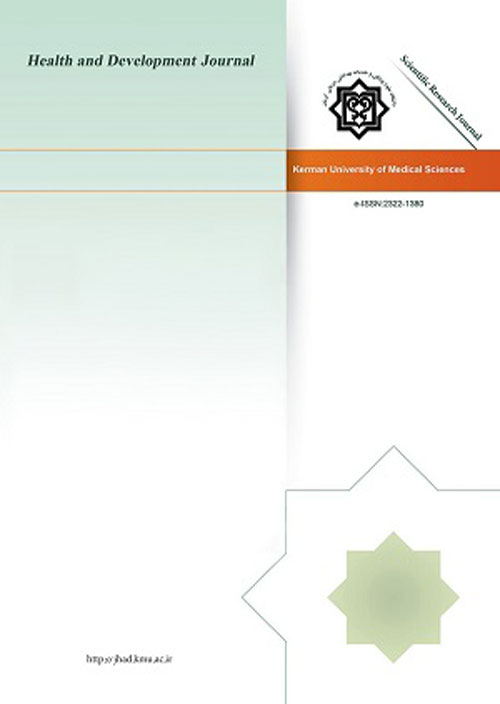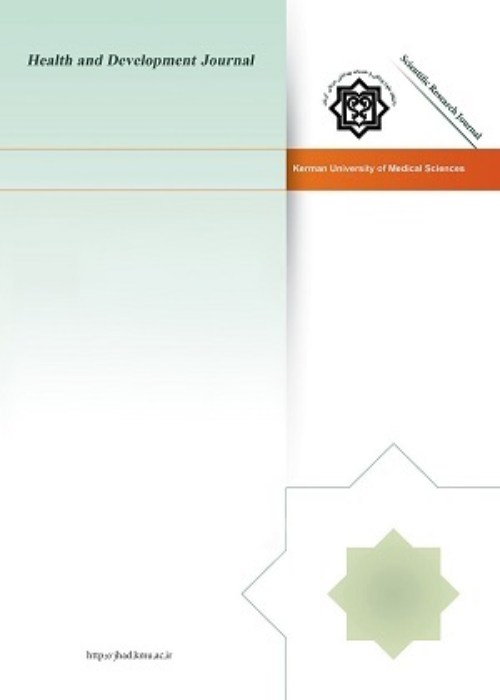فهرست مطالب

Health and Development Journal
Volume:10 Issue: 1, Winter 2021
- تاریخ انتشار: 1400/02/28
- تعداد عناوین: 8
-
-
Pages 1-9Background
Congenital malformations are defects that are present at birth. The purpose of the present study was to determine the status of congenital malformations and their risk factors in Noghab village, South Khorasan Province.
MethodsIn this case-control study, 152 cases with congenital anomalies and 152 controls were enrolled. A researcher-made checklist and face-to-face interviews were used to record patient data. Chi-square test, Mann-Whitney U, and univariate and multivariate logistic regression in SPSS 22 were used for statistical analysis.
ResultsOne hundred and nineteen (72.5%) patients were male. The overall prevalence of congenital abnormalities in the village was 4.5%. The most prevalent types of disorders were neurological (35.4%) and multiple abnormalities (30.5%). According to multivariate logistic regression, consuming barberries daily during pregnancy, having first-degree relatives with anomalies, daily use of herbal medicine and weekly consumption of pickled vegetables during pregnancy, and the existence of a chronic disease in the father were significantly associated with congenital disorders in the offspring.
ConclusionIn addition to the previously known risk factors for congenital malformation, consumption of barberries, herbal medicine and pickled vegetables during pregnancy, might be risk factors for congenital anomalies. These products should be used with caution in pregnant women.
Keywords: Genetic disorders, Congenital anomalies, Barberry, Prevalence, Iran -
Pages 10-16Background
Scorpion sting (SS) is an important public health hazard that may cause a potentially lethal condition especially in tropical and sub-tropical regions. Although scorpions are locally abundant in some parts of North Khorasan Province, SS has been poorly studied in this region. The current survey was carried out to investigate the epidemiological aspects of SS in North Khorasan Province, Iran.
MethodsThis cross-sectional descriptive-analytic study collected and analyzed the data of SS cases admitted to medical centers of different counties in North Khorasan Province including Bojnurd, Shirvan, Esfarayen, Jajarm, and Raz from 2007 to 2018. The descriptive statistical analyses were carried out with SPSS software (version 24), and logistic regression analyses were performed using the STATA software.
ResultsDuring the study period, 540 SS cases were admitted to hospitals, of whom 44 persons were hospitalized, and nearly half of them were male (50.2%). Most SS cases occurred indoors (58.4%). The mean age of the patients was 35±18.0 years. Furthermore, the annual number of SS cases varied with an increase in 2013. The most common site of the sting was in the hands (41.8%) followed by feet (40.5%). The most common time for SS occurrence was 12 a.m. to 6 a.m. (38%). The majority of victims admitted to the hospital less than 3 hours after the sting (84.6%) and all of them were recovered. The results of multiple regression analysis indicated that the risk of hospitalization in people who had more than one bite was significantly higher than those who had been bitten once.
ConclusionGiven the low average number of SS cases reported in the area compared to the south of Iran, SS does not seem to be an important health issue in this area except for Jajarm County.
Keywords: Scorpion sting, Epidemiology, Iran, North Khorasan -
Pages 17-29Background
The health sector directly contributes to economic growth and paves the way for the development of other economic sectors. This study investigates the short-term and long-term effects of health expenditure shocks and real exchange rate fluctuations, as well as the symmetry and asymmetry of these shocks on the logarithm of value-added of the health sector in the Iranian economy.
MethodsThe data related to the research variables were extracted from the website of the Central Bank of Iran (CBI) and the website of the World Bank. Using Eviews software (version 9) and applying the Hodrick-Prescott (HP) filter, health expenditure and real exchange rates were assessed as predictable and unpredictable shocks. Then, unpredictable shocks were decomposed into positive and negative components. In the next step, shocks were specified on the logarithm of value-added in the health sector along with control variables for the time period of 1973 to 2014.
ResultsEstimation of asymmetric health expenditure model and real exchange rate for the logarithm of value added of the health sector indicated different effects of health expenditure shocks in the short run and the symmetry of these shocks in the long run. But the effect of real exchange rate shocks on the logarithm of value added in the health sector in the short run and the persistence of these shocks in the long run were asymmetric and significant.
ConclusionThe effectiveness of health expenditure shocks on value added of the health sector in the short run is the basis for the growth of the country's macroeconomy and the effectiveness of real exchange rate shocks on the Iranian health sector, both in the short and long run, marks this variable as an important factor in the economic policies of the health sector.
Keywords: Health expenditure, Real exchange Rates, Health sector Value-Added, Econometric models -
Pages 39-45Background
Social anxiety is one of the most common psychological disorders that restrict the abilities of the affected people and cause various problems for them in social and performance-related situations. The objective of the present study was to investigate the effect of self-acceptance group therapy (SAGT) on students suffering from social anxiety.
MethodsThis interventional study employed a pretest-posttest design with one control group and a one-month follow-up. The research population consisted of all students with social anxiety who were studying at the University of Mohaghegh Ardabili during the academic year 2018-2019. Thirty-six students were selected based on their scores on Conor’s Social Phobia Inventory (SPIN) and information from structured interviews and were randomly assigned to the intervention group and control group (each with 18 members). The participants in the intervention group attended ten self-acceptance training sessions, but the participants in the control group did not receive any intervention. In addition to the post-intervention assessment, the participants in both groups underwent a one-month follow-up. Data were analyzed using repeated-measures analysis of variance (ANOVA) and independent samples t-test via SPSS software (version 22).
ResultsThe results showed that self-acceptance group therapy (SAGT) reduced social anxiety in the intervention group at the posttest and follow-up stages. However, no statistically significant difference was observed in social anxiety reported by the members of the control group at different stages.
ConclusionThe findings of this study confirmed the results of previous studies and has provided the preliminary basis for the use of this treatment. Future studies can further explore the effectiveness of this technique in coping with different issues.
Keywords: Social anxiety, Self-Acceptance, Group therapy, Students -
Pages 46-55Background
Providing food security to rural households is one of the goals pursued in national development plans. Therefore, off-farm income provides more financial resources to rural households and thus increases their food security. Given the role of food security in human health and development, the present research aims to explore the spatial effects of off-farm income on the food security of rural households in all provinces of Iran.
MethodsThe status of food security of rural households in Iran was determined using data from 206963 Household Income and Expenditure Surveys and the recommended dietary for the Iranian population. Besides, the effectiveness of off-farm income on food security of rural families along with other effective factors was investigated the first time using the panel spatial autoregressive (SAR) model for the period from 2006 to 2016 with Stata software.
ResultsThe results from the SAR model suggested that off-farm income has a positive and significant effect on the rural food security index. On the other hand, the significant value of the spatial lag coefficient of the dependent variable confirmed the existence of spatial effects, indicating that off-farm income has a positive and significant effect on food security.
ConclusionGiven that agricultural activities are mainly seasonal, off-farm activities along with conventional agricultural activities can improve the food security of rural households and prevent their migration to cities.
Keywords: Food security, Off-farm income, Spatial panel


